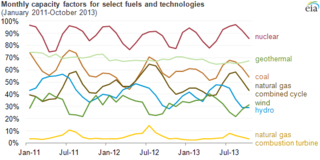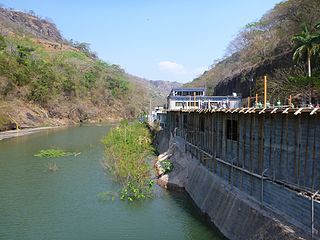
The net capacity factor is the unitless ratio of an actual electrical energy output over a given period of time to the maximum possible electrical energy output over that period. The capacity factor is defined for any electricity producing installation, such as a fuel consuming power plant or one using renewable energy, such as wind or the sun. The average capacity factor can also be defined for any class of such installations, and can be used to compare different types of electricity production.

The Tribute Power Station is a conventional hydroelectric power station located in Western Tasmania, Australia.
Many nations have installed significant solar power capacity into their electrical grids to supplement or provide an alternative to conventional energy sources. Solar power plants use one of two technologies:

The Nellis Solar Power Plant is a 14-megawatt (MW) photovoltaic power station located within Nellis Air Force Base in Clark County, Nevada, northeast of Las Vegas. The power plant was inaugurated in a ceremony on December 17, 2007, with Nevada Governor Jim Gibbons activating its full operation. On average, it has since generated 32 gigawatt-hours of electricity annually and supplied more than 25% of the power used at the base.
Guadarranque solar power plant is a photovoltaic solar power plant in the Guadarranque industrial park in San Roque, Cádiz, Spain. The plant is owned and operated by Endesa.

Electricity from renewable sources in Spain represented 42.8% of electricity demand coverage during 2014. The country has a very large wind power capability built up over many years and is one of the world leaders in wind power generation.
The Moura Photovoltaic Power Station is a large photovoltaic power station in Amareleja, in the municipality of Moura, Portugal. It is one of the largest power stations of its kind, and is built in one of the sunniest regions in Europe. Its construction involved two stages: stage 1 was completed in 2008 after 13 months, and stage 2 was completed in 2010. The entire project topped a total cost of €250 million.
Nuclearelectrica is a state-owned company, its shares being held by the Ministry of Economy and Commerce, which has as main objective power generation with the only nuclear power plant in Romania.
Planta Solar Fuente Álamo is a photovoltaic power station in Fuente-Álamo, Murcia in Spain. It covers an area of 62 hectares. The power station has a capacity of 26 megawatts and its annual output is 44 GWh, equivalent to supply electricity to 13,000 households.
The La Magascona and Magasquila photovoltaic power stations (Spanish: Planta Solar La Magascona and Spanish: Planta Solar Magasquila is a complex of photovoltaic power stations located at La Magascona, Trujillo in Cáceres, Spain. The La Magascona photovoltaic power station covers 100 hectares and it has a peak output of 23.04 MW. The power station produces approximately 46 GWh of electricity per year. It was commissioned in July 2007.
The El Coronil Solar Power Plant is a photovoltaic power station in El Coronil, Spain. The project includes different generating units. El Coronil I is a 10.08 MWp project that is equipped with 386 2X trackers, and 51,794 Yingli polycrystalline photovoltaic modules, and 24 Siemens inverters of 400 kW. The annual production capacity is 20 GWh. El Coronil II has a capacity of 10.2 MWp and it is equipped with 53,206 Yingli polycrystalline photovoltaic modules, and 24 inverters of 400 kW.
Calasparra Photovoltaic Power Plant is a photovoltaic power station in Calasparra, Murcia in Spain. The project consists of different production units. Calasparra II is a 6.67 MW ground-mounted unit with estimated annual output of 11.82 GWh. Calasparra III is a 6.6 MW units with estimated annual output of 11.7 GWh. The project was developed by FRV and constructed by Gestamp Solar.

The Sevilla Photovoltaic Power Plant was the largest low-concentrated CPV power plant in the world. The facility is located in the Solar Platform, a region dedicated to solar power developments, in Sanlúcar la Mayor, Spain.

The Aguacapa Dam is a reinforced concrete gravity dam and power plant spanning the Aguacapa River in Escuintla, Guatemala.
The Fürstenwalde Solar Park is a photovoltaic power station in Fürstenwalde, Germany. It has a capacity of 39.64 megawatt (MW) and an annual output of 36.5 GWh. The solar park was developed by the company Solarhybrid and built by conecon using 62,832 225-watt and 110,880 230-watt solar panels, both manufactured by Suntech.

Solar power in Belgium reached an installed capacity of 3,846 MW of power generating 3,149 GWh of electricity in 2017. In 2015 PV solar power accounted for around 4% of Belgium's total electricity demand, the 4th highest penetration figure in the world, although the country is some way behind the leaders Germany, Italy and Greece at between 7% and 8% of electricity demand.
Northern Chile has the highest solar incidence in the world. In October 2015 Chile's Ministry of Energy announced its "Roadmap to 2050: A Sustainable and Inclusive Strategy", which plans for 19% of the country's electricity to be from solar energy, 23% wind power and 29% hydroelectric power.

Jabban (Malakand-I) Hydropower Plant (MHPP-I) is a small, low-head, run-of-the-river hydroelectric power generation station of 22 megawatt generation capacity, located at Jabban, Malakand District, KPK province of Pakistan on the flows of Swat River and about 210 km from Pakistan's Capital Islamabad, 45 km from the city of Mardan and 7 km upstream of 20 MW Dargai Hydropower Plant (Malakand-II). It is a small hydel power generating plant constructed and put in commercial operation on July 1938 generating Average Annual yield of 122 million units (GWh) of least expensive electricity.

Solar power in Switzerland has been growing rapidly in recent years due to declining system costs and a feed-in tariff instituted by the Swiss government. In 2013, cumulative capacity increased by 69% to 730 megawatts (MW) and contributed 544 GWh or 0.8% of the countries net-electricity production.
Mount Signal Solar, also known as Imperial Valley Solar Project, is a 594 MWp (460 MWAC) photovoltaic power station west of Calexico, California in the southern Imperial Valley, near the Mexican border. The facility is being developed and constructed by 8minutenergy Renewables in three phases, with two completed as of 2018. At full build-out, it will be one of the world's largest PV solar farms with a capacity of about 800 MWp (600 MWAC). The project has been supported by several environmental groups, as the power station was built on low productivity farmland.











